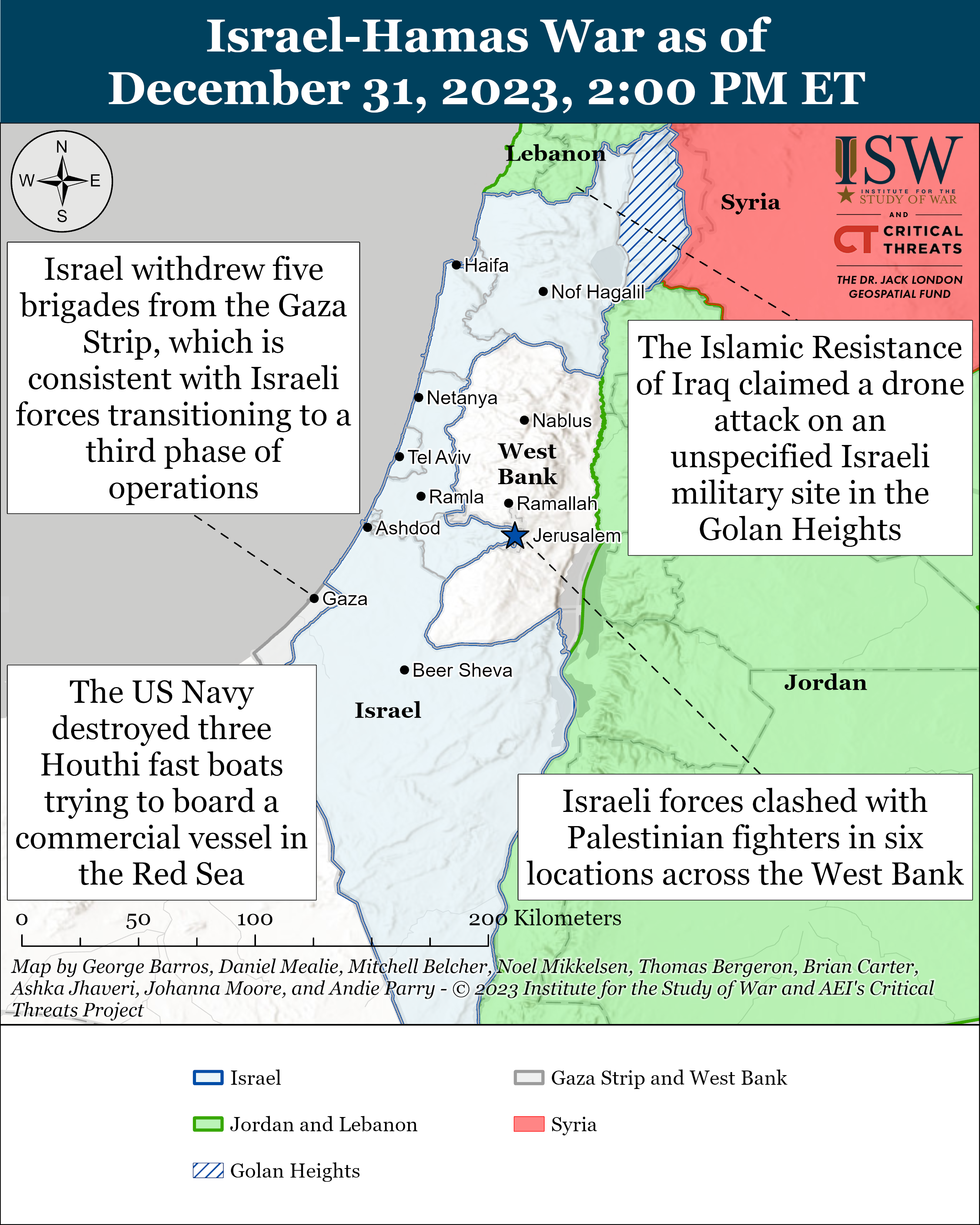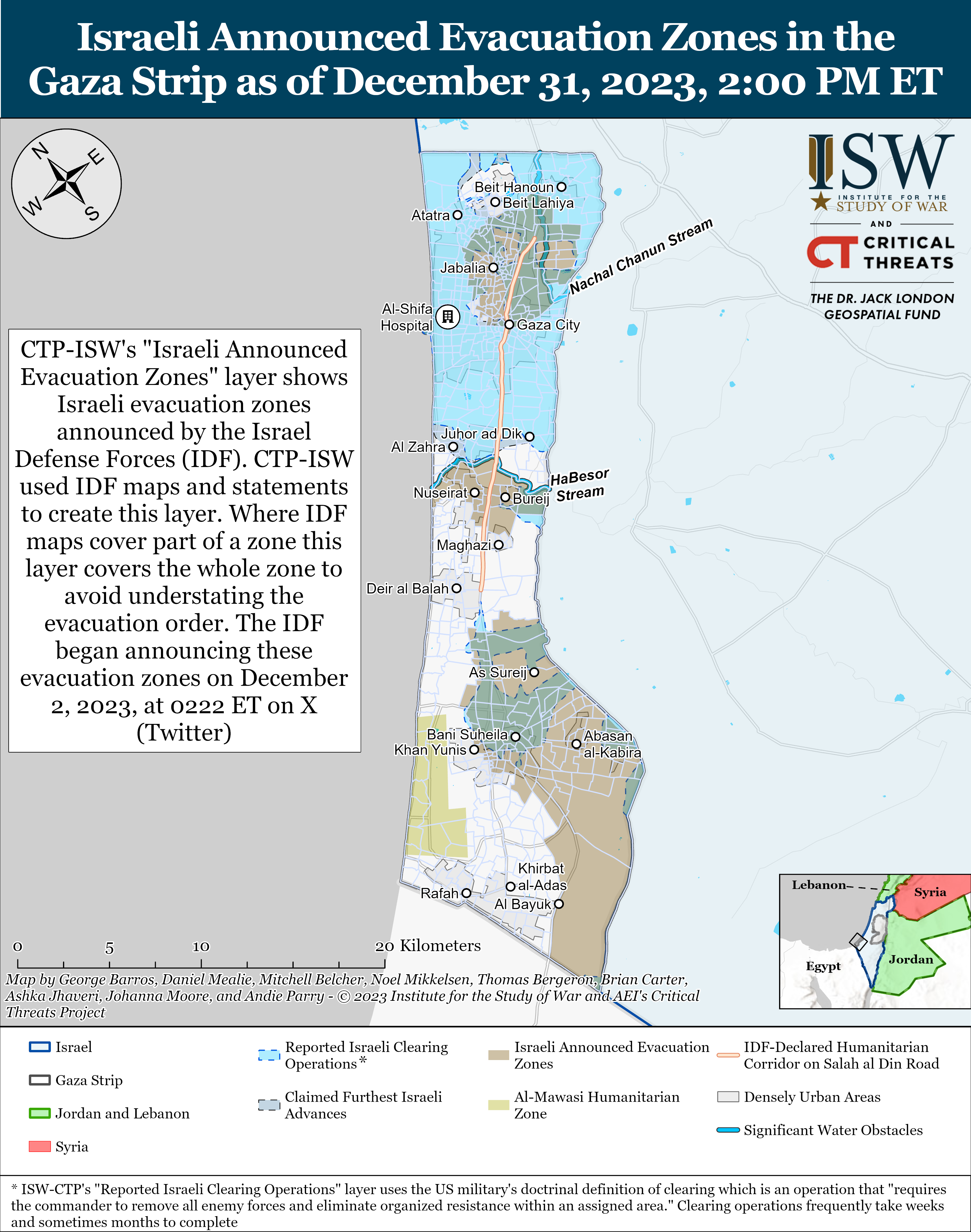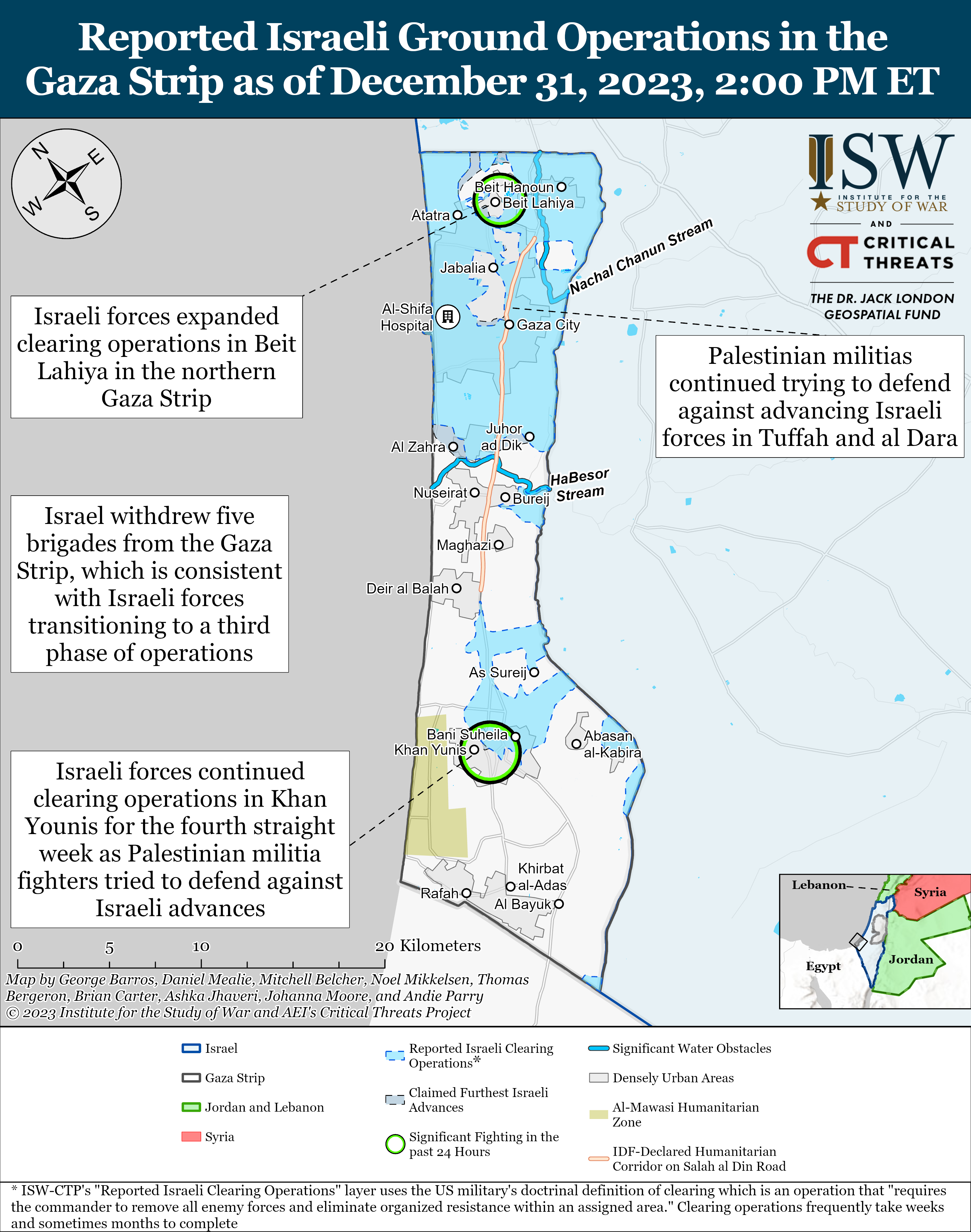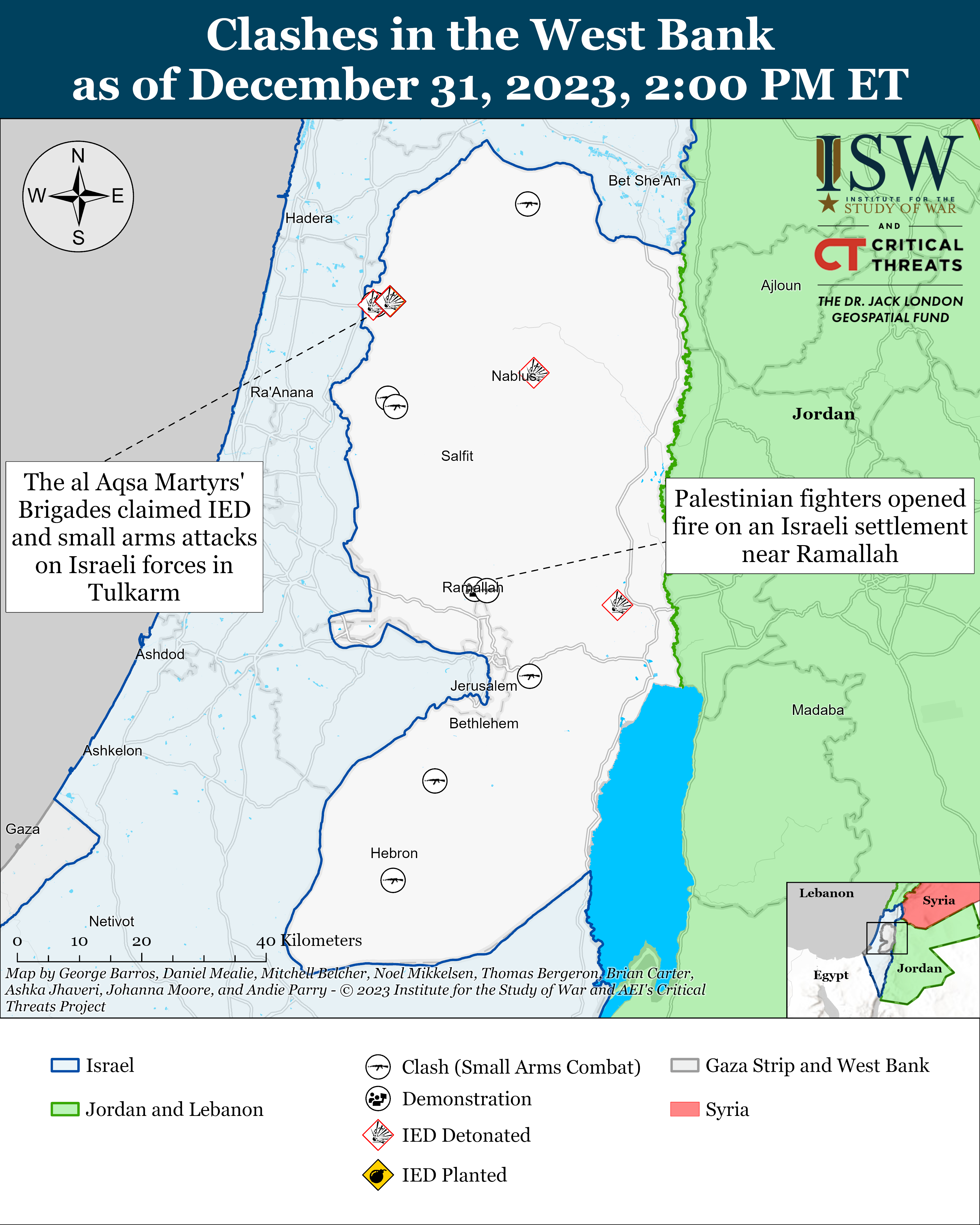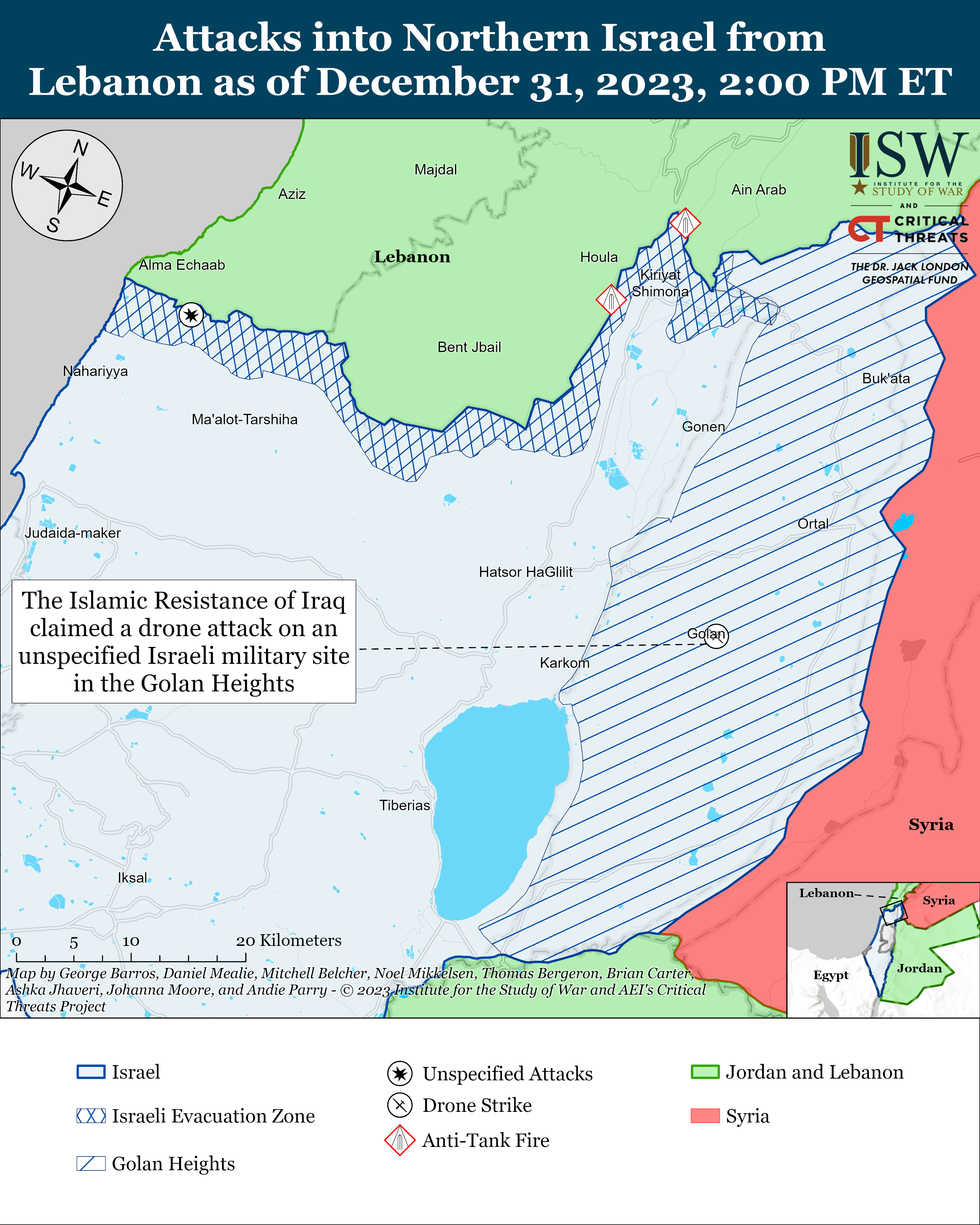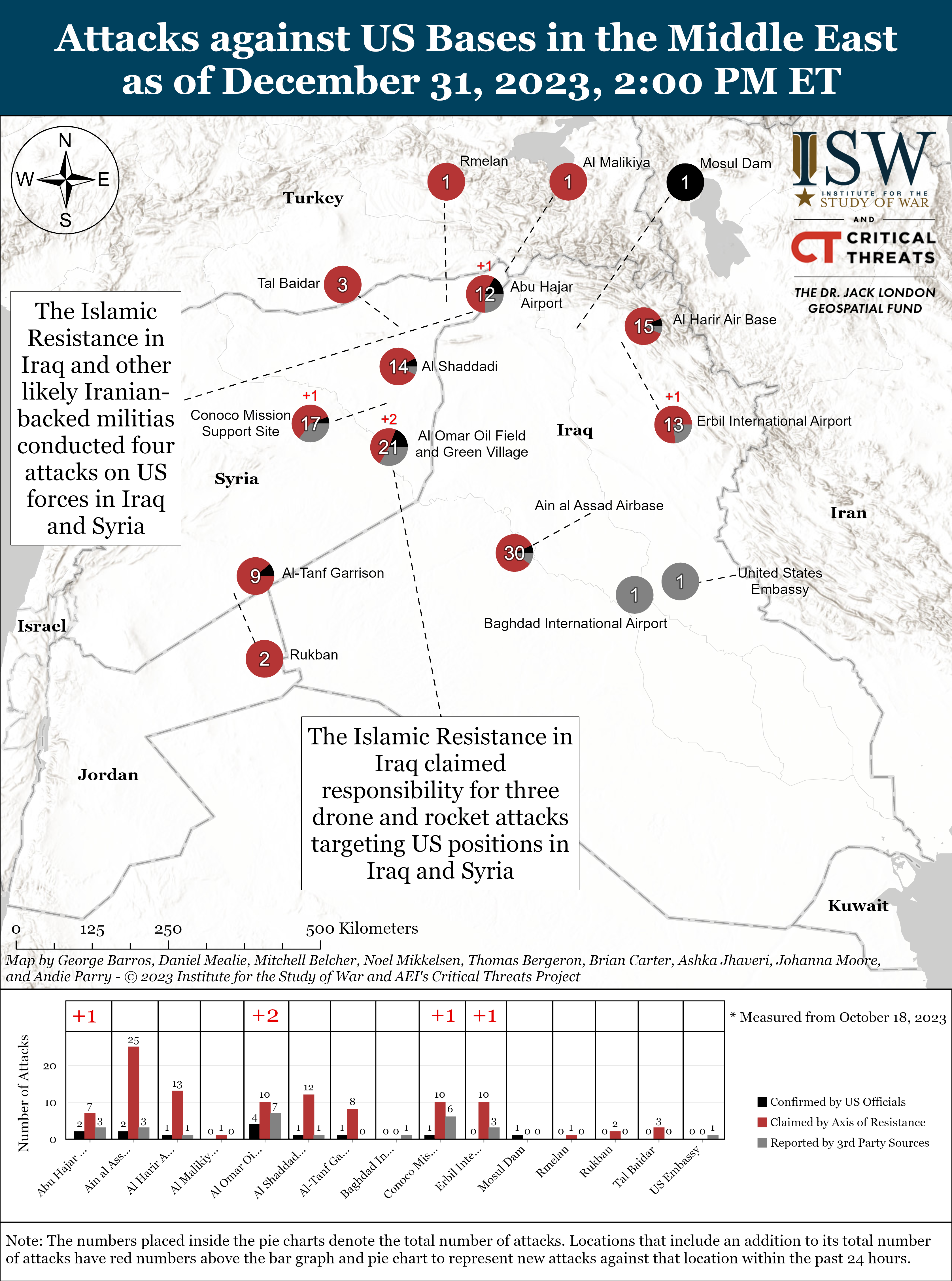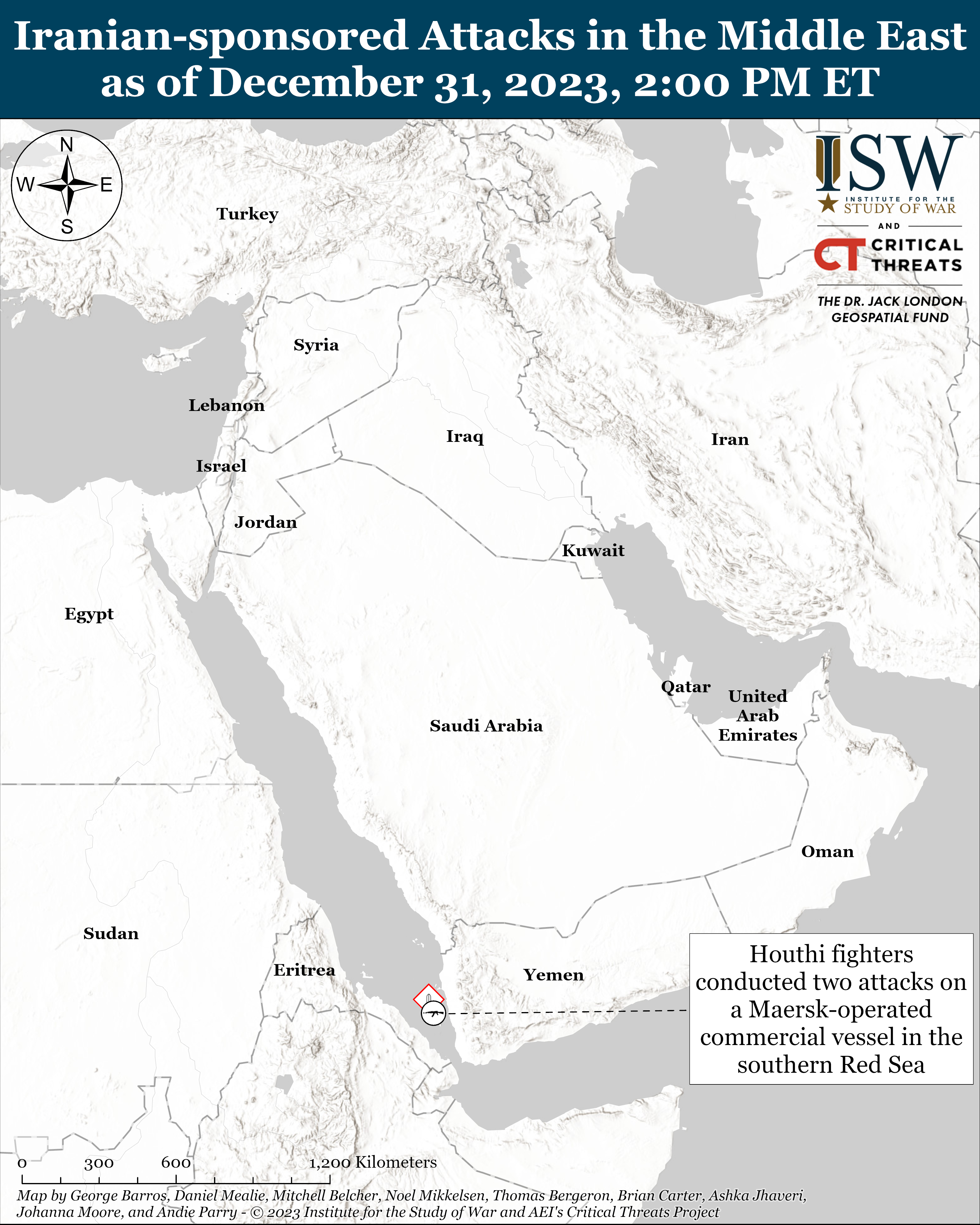 |
 |
Iran Update, December 31, 2023
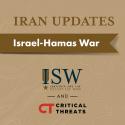
Iran Update, December 31, 2023
Ashka Jhaveri, Amin Soltani, Johanna Moore, Peter Mills, and Nicholas Carl
Information Cutoff: 2:00 pm EST
The Critical Threats Project and the Institute for the Study of War will not publish an Iran Update (Israel-Hamas War) on January 1, 2024, due to the Near Year holiday. We will resume publication of the Iran Update (Israel-Hamas War) on January 2, 2024.
The Iran Update provides insights into Iranian and Iranian-sponsored activities abroad that undermine regional stability and threaten US forces and interests. It also covers events and trends that affect the stability and decision-making of the Iranian regime. The Critical Threats Project (CTP) at the American Enterprise Institute and the Institute for the Study of War (ISW) provides these updates regularly based on regional events. For more on developments in Iran and the region, see our interactive map of Iran and the Middle East.
Note: CTP and ISW have refocused the update to cover the Israel-Hamas war. The new sections address developments in the Gaza Strip, the West Bank, Lebanon, and Syria, as well as noteworthy activity from Iran’s Axis of Resistance. We do not report in detail on war crimes because these activities are well-covered in Western media and do not directly affect the military operations we are assessing and forecasting. We utterly condemn violations of the laws of armed conflict and the Geneva Conventions and crimes against humanity even though we do not describe them in these reports.
Click here to see CTP and ISW’s interactive map of Israeli ground operations. This map is updated daily alongside the static maps present in this report.
Key Takeaways:
- Israeli forces advanced into Beit Lahiya for clearing operations in the northern Gaza Strip. Palestinian militias attempted to defend against Israeli forces operating in Tuffah and al Daraj in Gaza City. Palestinian militias did not claim any attacks in Jabalia City and Sheikh Radwan neighborhood.
- Palestinian militias are clashing with Israeli forces in al Bureij in the Central Governorate of the Gaza Strip.
- Israeli forces continued clearing operations in Khan Younis for the fourth straight week as Palestinian militia fighters tried to defend against Israeli advances. Palestinian militias have sustained almost daily attacks on Israeli forces in Khan Younis since Israel forces advanced into the southern Gaza Strip in early December.
- Israel has withdrawn five IDF brigades from the Gaza Strip, which is consistent with Israeli forces transitioning to a third phase of operations. The third phase will include the end of major combat operations, a “reduction in forces” in the Gaza Strip, the release of reservists, a “transition to targeted raids,” and the establishment of a security buffer zone within the Gaza Strip.
- An unspecified Israeli intelligence officer told the Economist that most of Hamas’ command structure is “gone” and that Hamas is no longer operating as a military organization. CTP-ISW assesses that at least three of 30 Hamas battalions in the five brigades are combat ineffective, at least eight battalions are degraded, and at least 12 battalions are currently under intense IDF pressure.
- An Israeli Army Radio correspondent reported that IDF sources believe the intensification of fighting on the ground in the Gaza Strip has contributed to a reduction in Palestinian rocket capabilities. Palestinian militias did not claim any indirect fire attacks into Israel from the Gaza Strip.
- Israeli forces clashed with Palestinian fighters in six locations across the West Bank.
- Iranian-backed fighters, including Lebanese Hezbollah, conducted four attacks from southern Lebanon into northern Israel. LH Deputy Secretary General Naim Qassem stated that LH will not allow displaced Israeli civilians to return to their homes in northern Israel until Israel halts its military operations in the Gaza Strip.
- Iranian-backed militants conducted two attacks on US forces stationed at Conoco Mission Support Site and al Omar oil field on December 30. The Islamic Resistance in Iraq—a coalition of Iranian-backed Iraqi militias—conducted two attacks targeting US forces in Iraq and Syria on December 31.
- Houthi fighters conducted two attacks on the MV Maersk Hangzhou container ship in the southern Red Sea. The Houthis likely focused on attacking a Maersk-operated vessel in particular because Maersk announced that it would resume its operations in the Red Sea on December 24. These Houthi attacks are part of a broader regional escalation that Iran is leading against the United States and Israel.
- Supreme National Security Council Secretary Rear Admiral Ali Akbar Ahmadian discussed the Israel-Hamas war with senior Houthi official Mohammad Abdul Salam in Tehran.
Gaza Strip
Axis of Resistance campaign objectives:
- Erode the will of the Israeli political establishment and public to launch and sustain a major ground operation into the Gaza Strip
- Degrade IDF material and morale around the Gaza Strip.
Israeli forces advanced into Beit Lahiya for clearing operations in the northern Gaza Strip. An Israeli Brigade Combat Team identified three Hamas fighters inside a building and directed an airstrike at their position in Beit Lahiya, according to an IDF report on December 31.[1] The al Qassem Brigades—the militant wing of Hamas—intercepted an Israeli reconnaissance drone in Beit Lahiya on December 31.[2] Israeli forces initially advanced into the Gaza Strip west of Beit Lahiya in late October.[3] Commercially available satellite imagery captured on December 31 shows recently flattened terrain in Beit Lahiya City and north of the city, which suggests that Israeli tanks or bulldozers recently began operating in the area. The Wall Street Journal published a map of the tunnel system that Hamas has created below the Gaza Strip based on data from 2014, which includes an extensive tunnel network in Beit Lahiya.[4] Palestinian militia fighters have used tunnel shafts to maneuver through the strip and to ambush Israeli forces.[5] The IDF has located about 1,500 tunnel shafts and routes in the Gaza Strip since the beginning of the ground operation in the Gaza Strip, according to an IDF report on December 19.[6]
Palestinian militias attempted to defend against Israeli forces operating in Tuffah and al Daraj in Gaza City. The al Qassem Brigades and al Quds Brigades—the militant wing of Palestinian Islamic Jihad (PIJ)—claimed several attacks on Israeli forces operating in the neighborhoods.[7] The al Qassem Brigades claimed to detonate a Shawaz explosively formed penetrator (EFP) in the neighborhoods, targeting five Israeli vehicles.[8] EFPs are particularly lethal improvised explosive devices designed to penetrate armored vehicles, such as main battle tanks.[9]
Palestinian militias did not claim any attacks in Jabalia City and Sheikh Radwan neighborhood on December 31. CTP-ISW assessed on December 22 that Hamas’ Jabalia al Balad Battalion is degraded and that the Radwan Battalion remains combat effective.[10] Both battalions are facing active and intense IDF pressure, as Israeli forces continue advancing into these areas.[11] Palestinian militias have claimed nearly daily attacks in Sheikh Radwan neighborhood since the humanitarian pause expired on December 1, which suggests that it is one of the remaining areas where they maintain significant defensive infrastructure. The absence of Palestinian attack claims does not necessarily indicate that Hamas lacks the capability to launch attacks in the area, however. Palestinian militias have reported losing contact with specific units for short periods of time in the Gaza Strip, which could have happened in Jabalia City and Sheikh Radwan neighborhood.[12]
Israeli forces continued executing tasks consistent with holding operations in some areas of Gaza City. CTP-ISW reported on December 20 that Israeli forces are transitioning from clearing operations to holding operations in some areas of the northern Gaza Strip.[13] The hold phase is defined by a decreased level of violence but still requires holding forces to engage and eliminate enemy forces and infrastructure to provide security.[14] Palestinian militia attacks in these areas demonstrate that the militias have retained some forces capable of targeting Israeli operations.
- Israeli forces searched the homes of Palestinian militia fighters in al Shaati refugee camp in northern Gaza City.[15] Unspecified Palestinian fighters had planted IEDs in the vicinity of a kindergarten in advance of the arrival of Israeli forces.
- Israeli forces conducted an airstrike targeting a suspicious vehicle that Palestinian fighters were driving toward Israeli ground elements in southern Gaza City.[16]
- The al Quds Brigades detonated a tunnel entrance rigged with explosives targeting Israeli infantrymen in Shujaiya neighborhood, where Israeli forces have been executing tasks consistent with holding operations for over a week.[17]
Palestinian militias are clashing with Israeli forces in al Bureij in the Central Governorate of the Gaza Strip. The al Qassem Brigades published footage on December 31 of its forces moving through buildings to launch rocket propelled grenades (RPG) at Israeli tanks—a tactic that the militia has employed heavily across the Gaza Strip.[18] The IDF said that it expanded clearing operations in Bureij in the central Gaza Strip on December 26 to target Hamas’ Bureij Battalion.[19] The IDF Arabic-language media spokesperson repeated on December 31 evacuation orders covering areas of the central Gaza Strip.[20] Residents of al Bureij refugee camp, Badr, northern coast, al Nuzha, al Zahra, al Buraq, al Salam, al Fayha, al Basma, al Bawadi, al Rawdah, and al Safah must move to shelters in Deir al Balah, according to the IDF evacuation orders.[21]
Israeli forces continued clearing operations in Khan Younis for the fourth straight week as Palestinian militia fighters tried to defend against Israeli advances. The IDF reported on December 31 that an airborne brigade deployed to Khan Younis in recent days after two months of intense fighting in the northern Gaza Strip.[22] The brigade joined special operations, armored, engineering, and air elements in clearing Khan Younis Governorate of militia infrastructure, such as observation outposts, anti-tank positions, and weapons depots.[23] Palestinian fighters emerged from a tunnel shaft in one encounter and attempted to fire RPGs before Israeli forces returned fire.[24] Israeli air and armored elements killed the remaining Palestinian fighters.[25] The IDF also destroyed unspecified militia infrastructure belonging to the commanders of Hamas’ South Khan Younis Battalion, one of five in the governorate.[26]
Palestinian militias have sustained almost daily attacks on Israeli forces in Khan Younis since Israeli forces advanced into the southern Gaza Strip in early December. The al Qassem Brigades claimed three attacks on Israeli forces using mortars and anti-tank RPGs.[27] The National Resistance Brigades—the militant wing of the Democratic Front for the Liberation of Palestine (DFLP)—claimed to target an Israeli tank with an unspecified explosive device north of Khan Younis.[28] The al Nasser Salah al Din Brigades—the militant wing of the Popular Resistance Committees—claimed that its fighters targeted an Israeli tank with a tandem-charged anti-tank rocket in Khan Younis.[29] The al Qassem Brigades and National Resistance Brigades claimed separate mortar attacks on Israeli forces east of Khuzaa, where the IDF began clearing operations on December 27.[30]
Israel has withdrawn five IDF brigades from the Gaza Strip, which is consistent with Israeli forces transitioning to a third phase of operations. The IDF confirmed the withdrawals and that it will include some reservists.[31] Some of these brigades had deployed to and fought in the northern Gaza Strip.[32] Three of the five brigades are training brigades, which are responsible for training officers, tank personnel, and non-commissioned officers during peacetime.[33] Israel’s public broadcaster reported on December 23 that the IDF will transition to the third phase of its ground operation in the Gaza Strip in the “coming weeks.”[34] The report said that the third phase will include the end of major combat operations, a “reduction in forces” in the Gaza Strip, the release of reservists, a “transition to targeted raids,” and the establishment of a security buffer zone within the Gaza Strip.
An unspecified Israeli intelligence officer told the Economist on December 30 that most of Hamas’ command structure is “gone” and that Hamas is no longer operating as a military organization.[35] The officer noted that Hamas maintains many fighters who have reverted to guerilla tactics.
CTP-ISW assesses that at least three of 30 Hamas battalions in the five brigades are combat ineffective, at least eight battalions are degraded, and at least 12 battalions are currently under intense IDF pressure.[36] Hamas has a conventional military order of battle but has fought this war and historically as an irregular (guerilla) force. Hamas very likely retains a deep bench of experienced military commanders.[37] Israeli forces are still actively clearing in some parts of the northern Gaza Strip in addition to the Gaza Strip’s Central and Khan Younis governorates, where Hamas maintains combat effective units. Combat effectiveness measures a unit’s ability to perform its mission; a unit is combat ineffective when it is no longer able to complete its mission.[38] The IDF reported on December 26 that all four battalions in Hamas’ Central Gazan Brigade have sustained “some damage” but are “largely functioning.”[39] Hamas’ combat ineffective units are still capable of waging low-level warfare and reconstituting.
An Israeli Army Radio correspondent reported on December 31 that IDF sources believe the intensification of fighting on the ground in the Gaza Strip has contributed to a reduction in Palestinian rocket capabilities.[40] Palestinian militias did not claim any indirect fire attacks into Israel from the Gaza Strip on December 31. CTP-ISW initially assessed that Israeli clearing operations were likely degrading Hamas’ capacity to conduct indirect fire attacks into Israel from the Gaza Strip on December 12.[41]
The IDF estimates that the war will not completely reduce rocket fire from the Gaza Strip into Israel, however. Israeli clearing operations are primarily focused on dismantling Hamas in the Gaza Strip.[42] The IDF noted that the success of their operations in the strip does not preclude a “lone terrorist” from conducting indirect fire attacks into Israel. Several Palestinian militias operating in the Gaza Strip maintain rocket arsenals and have claimed indirect fire attacks into Israel.[43]
West Bank
Axis of Resistance campaign objectives:
- Draw IDF assets and resources toward the West Bank and fix them there
Israeli forces clashed with Palestinian fighters in six locations across the West Bank on December 31.[44] The al Aqsa Martyrs’ Brigades and one of its affiliated groups, the Tulkarm Rapid Response Battalion, claimed that they conducted IED and small arms attacks on Israeli forces around Tulkarm on December 30-31.[45] Unspecified Palestinian fighters threw IEDs at Israeli forces in Nablus, Tulkarm, and Jericho on December 31.[46] The al Aqsa Martyrs’ Brigades separately claimed three small arms attacks on Israeli forces and settlements near Qalqilya and Nablus on December 30.[47] Unspecified Palestinian fighters fired small arms and threw Molotov cocktails at Israeli forces near Hebron on December 30.[48] Fatah organized a demonstration against Israeli operations in the Gaza Strip in Ramallah on December 31.[49]
This map is not an exhaustive depiction of clashes and demonstrations in the West Bank.
Southern Lebanon and Golan Heights
Axis of Resistance campaign objectives:
- Draw IDF assets and resources toward northern Israel and fix them there
- Set conditions for successive campaigns into northern Israel
Iranian-backed fighters, including Lebanese Hezbollah (LH), conducted four attacks from southern Lebanon into northern Israel on December 31. LH fired anti-tank guided missiles and other unspecified munitions toward three Israeli border positions.[50] Unspecified fighters separately launched rockets toward Metula on December 31.[51] The IDF Air Force conducted airstrikes on LH military infrastructure in Ramiya, southern Lebanon.[52] The IDF stated that LH uses villages along the border to facilitate attacks on Israeli border positions.[53]
LH Deputy Secretary General Naim Qassem stated on December 31 that LH will not allow displaced Israeli civilians to return to their homes in northern Israel until Israel halts its military operations in the Gaza Strip.[54] Qassem stated that LH is in a state of war with Israel and that its forces along the border were positioned accordingly.[55] Qassem also warned that Israeli attacks harming Lebanese civilians would lead to a stronger but proportional response from LH.[56] Head of the Maronite Church Bechara Boutros al Rahi called for LH to withdraw its rocket units from civilian areas in southern Lebanon to avoid IDF retaliation.[57]
Iran and Axis of Resistance
Axis of Resistance campaign objectives:
- Demonstrate the capability and willingness of Iran and the Axis of Resistance to escalate against the United States and Israel on multiple fronts
- Set conditions to fight a regional war on multiple fronts
Iranian-backed militants conducted two attacks on US forces stationed at Conoco Mission Support Site and al Omar oil field on December 30.[58] The militants fired three drones at Conoco Mission Support Site and 14 rockets at al Omar oilfield, according to an unnamed US defense official.[59] The attack on Conoco is the largest barrage of rockets fired at US forces in a single attack that CTP-ISW has recorded since the Israel-Hamas war began, although it is possible that comparable or larger attacks have occurred and that such details have not been published. Syrian opposition media reported that Kataib Hezbollah and other Iranian-backed Iraqi militias were responsible for the December 30 attacks.[60] CTP-ISW previously assessed that the Iranian-led Axis of Resistance may escalate further against US forces in the region in the coming days, especially around the four-year anniversary of the US killing former IRGC Quds Force Commander Major General Qassem Soleimani on January 3, 2024.[61] Iranian leaders have vowed to expel US forces from the region as part of their revenge for the United States killing Soleimani.[62] The IRGC Quds Force engaged senior Iranian-backed Iraqi militia and political leaders likely to discuss their military and political campaign to expel US forces on December 30, as CTP-ISW previously reported.[63]
The Islamic Resistance in Iraq—a coalition of Iranian-backed Iraqi militias—conducted two attacks targeting US forces in Iraq and Syria on December 31. The Islamic Resistance in Iraq claimed two separate drone attacks on US forces at Rmelan Landing Zone, Syria, and Erbil International Airport, Iraq.[64]
Kataib Hezbollah (KH) commemorated its fight against the United States in several posts on its Telegram page on December 31. KH claimed that the United States deployed military advisors to Iraq under false pretexts to reoccupy Iraq and reshape the Middle East according to Israeli interests.[65] KH also celebrated the fourth anniversary of the storming of the US Embassy in Baghdad on December 31, 2019, and 12th anniversary of the US troop withdrawal in 2011.[66] KH also applauded its fighters' continued dedication to removing the United States from Iraq.[67]
Houthi fighters conducted two attacks on the MV Maersk Hangzhou container ship in the southern Red Sea. Likely Houthi fighters conducted a missile attack on the ship on December 30.[68] The USS Gravely destroyer intercepted two anti-ship missiles targeting the Hangzhou, while responding to a distress call from the ship.[69] Four Houthi fast attack craft later approached the Hangzhou, firing on the container ship and attempting to board it.[70] The USS Gravely and USS Eisenhower aircraft carriers sent helicopters to the container ship and issued verbal messages to the Houthi boats, which then fired on the helicopters.[71] The helicopters returned fire in self-defense and sank three of the four Houthi boats, killing ten Houthi members.[72] The fourth Houthi boat fled the area.
Houthi military spokesperson Yahya Saree said that Houthi fighters had been performing their regular duties to provide security and stability in the Red Sea by preventing Israeli ships or ships en route to Israel from passing.[73] Saree accused the United States of attempting to expand the conflict into the Red Sea and warned other countries of being complicit to US efforts.[74] Saree’s statement notably quoted a Quranic verse that LH and the Islamic Resistance of Iraq regularly cite as justification for their attacks on the United States or Israel. The use of the passage across the Axis of Resistance members is likely meant to signal their unity to external actors, while framing their regional escalation as some kind of religious duty.
The Houthis likely focused on attacking a Maersk-operated vessel in particular because Maersk announced that it would resume its operations in the Red Sea on December 24.[75] CTP-ISW previously assessed that the Iranian and Houthi anti-shipping attack campaign is meant to demonstrate the capability and willingness of the Axis of Resistance to threaten multiple strategic maritime chokepoints across the Middle East. The Houthi framing that the anti-shipping attack campaign is meant to only prevent commercial traffic to Israel is inaccurate, as the Houthi attacks have targeted multiple ships with no immediate connection to Israel or Israeli interests. Maersk announced that it would again suspend its operations in the Red Sea—this time for 48 hours—on December 31.[76]
These Houthi attacks are part of a broader regional escalation that Iran is leading against the United States and Israel. This regional escalation is meant to achieve Iran’s broader regional ambitions rather than achieve any discrete effects vis-a-vis the Israeli military operation in the Gaza Strip. This Iran-led escalation includes the almost daily drone, missile, and rocket attacks that Iranian-backed militias have conducted against US forces in Iraq and Syria. Iran and its proxies and partners in the Axis of Resistance are framing falsely this escalation as a response to the Israeli military operations in the Gaza Strip. Iran and its Axis of Resistance have a long history of threatening American servicemembers and international shipping prior to the war because it supports their grand strategic objectives in the Middle East. The current escalation is thus meant to help Iran attain regional hegemony, destroy the Israeli state, and expel US forces from the Middle East. The Israel-Hamas war provides informational cover to Iran and the Axis of Resistance, allowing them to misrepresent their long-standing campaigns as meant to support the Palestinian cause.
Iranian Foreign Affairs Minister Hossein Amir Abdollahian discussed recent Houthi attacks on international shipping in the Red Sea during a phone call with his British counterpart, David Cameron, on December 31.[77] Abdollahian suggested that Houthi attacks on maritime traffic would continue so long as Israel continues its military operations in the Gaza Strip. Cameron stated that Iran bears responsibility for the Houthi attacks given its long-standing support for the Houthis. The Houthis have conducted an anti-shipping attack campaign around the Red Sea in recent weeks to disrupt commercial shipping to Israel and demonstrate both the willingness and capability of the Axis of Resistance to disrupt maritime traffic around strategic maritime chokepoints.[78]
Supreme National Security Council Secretary Rear Admiral Ali Akbar Ahmadian discussed the Israel-Hamas war with senior Houthi official Mohammad Abdul Salam in Tehran on December 31.[79] Ahmadian praised the Houthis for their support of the Palestinians against Israeli “aggression.”
Iranian Supreme Leader Ali Khamenei met with the family of Qassem Soleimani on December 31.[80] Khamenei praised how Soleimani strengthened the Axis of Resistance and called on the IRGC Quds Force to further strengthen it. IRGC Commander Major General Hossein Salami and IRGC Quds Force Commander Brigadier General Esmail Ghaani attended the meeting. IRGC-affiliated media emphasized that Khamenei’s insistence on continuing to strengthen the Axis of Resistance was directed at Ghaani.[81]
Iranian President Ebrahim Raisi met with the family of IRGC Brigadier General Razi Mousavi, whom Israel killed in an airstrike in Syria, on December 31.[82] Raisi threatened that Israel “would pay the price” for killing Mousavi. Western and anti-regime media have reported that Mousavi headed IRGC Quds Force Unit 2250, which manages Iranian weapons shipments to LH and Iranian-backed militias in Syria.[83] Senior Iranian military and political officials have attended Mousavi’s commemoration and funeral ceremonies in recent days, highlighting his prominence in the regime and its regional project.[84]

[1] https://twitter.com/idfonline/status/1741350835643154674
[2] https://t.me/qassambrigades/29846; https://t.me/qassambrigades/29849
[3] https://www.understandingwar.org/backgrounder/iran-update-november-4-2023
[4] https://www.wsj.com/livecoverage/israel-hamas-war-biden/card/map-shows-labyrinth-of-tunnels-made-by-hamas-under-gaza-identified-by-israel-IieNDixn5Bs78HeUi46v
[5] https://twitter.com/GLZRadio/status/1733756968756510981; https://t.me/sarayaps/16880
[6] https://www.idf dot il/164023
[7] https://t.me/qassam1brigades/1148; https://t.me/qassam1brigades/1149; https://t.me/sarayaps/17117
[8] https://t.me/qassam1brigades/1149
[9] https://taskandpurpose.com/tech-tactics/efp-explosively-formed-penetrator-projectile/
[10] https://www.understandingwar.org/backgrounder/order-battle-hamas%E2%80%99-izz-al-din-al-qassem-brigades
[11] https://www.understandingwar.org/backgrounder/order-battle-hamas%E2%80%99-izz-al-din-al-qassem-brigades
[12] https://t.me/sarayaps/16947
[13] https://www.understandingwar.org/backgrounder/iran-update-december-20-2023
[14] https://irp.fas.org/doddir/army/fm3-24.pdf
[15] https://twitter.com/idfonline/status/1741350811840528536
[16] https://twitter.com/idfonline/status/1741350833768243301
[17] https://twitter.com/GLZRadio/status/1738264100071723440; https://t.me/sarayaps/17116
[18] https://t.me/qassam1brigades/1152
[19] https://www.understandingwar.org/backgrounder/iran-update-december-26-2023
[20] https://twitter.com/AvichayAdraee/status/1741373286901043422
[21] https://twitter.com/AvichayAdraee/status/1741373286901043422
[22] https://www.idf dot il/168132
[23] https://www.idf dot il/168132
[24] https://www.idf dot il/168132
[25] https://www.idf dot il/168132
[26] https://www.understandingwar.org/backgrounder/order-battle-hamas%E2%80%99-izz-al-din-al-qassem-brigades ; https://www.idf dot il/168132
[27] https://t.me/qassam1brigades/1146 ; https://t.me/qassam1brigades/1150 ; https://t.me/qassambrigades/29845
[28] https://t.me/kataeb_moqawma/4029
[29] https://t.me/alwya2000/6156
[30] https://t.me/qassambrigades/29847 ; https://t.me/kataeb_moqawma/4031
[31] https://twitter.com/manniefabian/status/1741509504842273078 ; https://twitter.com/GLZRadio/status/1741503980427944111
[32] https://twitter.com/manniefabian/status/1722253475399225668 ; https://twitter.com/GLZRadio/status/1737141768473170371
[33] https://twitter.com/manniefabian/status/1741509504842273078 ; https://twitter.com/GLZRadio/status/1741503980427944111
[34] https://www.kan dot org.il/content/kan-news/defense/660419 ; https://www.haaretz dot com/israel-news/2023-12-22/ty-article/.premium/the-unbridgeable-gulf-between-israeli-politicians-rhetoric-and-the-reality-in-gaza/0000018c-8e1e-da31-adff-8e5eb1060000
[35] https://www.economist.com/middle-east-and-africa/2023/12/30/israel-prepares-for-a-long-war-in-gaza
[36] https://www.understandingwar.org/backgrounder/order-battle-hamas%E2%80%99-izz-al-din-al-qassem-brigades
[37] https://www.understandingwar.org/backgrounder/order-battle-hamas%E2%80%99-izz-al-din-al-qassem-brigades
[38] https://irp.fas.org/doddir/army/fm1-02-1.pdf
[39] https://twitter.com/manniefabian/status/1739697912701960660
[40] https://twitter.com/Doron_Kadosh/status/1741330619815149898
[41] https://www.understandingwar.org/backgrounder/iran-update-december-12-2023
[42] https://twitter.com/Doron_Kadosh/status/1741330619815149898
[43] https://t.me/sarayaps/16886; https://t.me/kataeb_moqawma/3991; https://t.me/mihwar_almuqawama/38696; https://t.me/QudsN/338858
[44] https://t.me/alredalsrey/520 https://t.me/QudsN/351534 ; https://t.me/elaqsa_1965/5413 ; https://twitter.com/idfonline/status/1741381686137323820 ; https://t.me/QudsN/351635 ; https://t.me/QudsN/351826 ; https://t.me/QudsN/351841
[45] https://t.me/QudsN/351542 ; https://t.me/elaqsa_1965/5412 ; https://t.me/alredalsrey/520 ; https://t.me/elaqsa_1965/5413
[46] https://t.me/QudsN/351534 ; https://twitter.com/idfonline/status/1741381686137323820 ; https://t.me/QudsN/351635
[47] https://t.me/kataebaqsapalestine/2635 ; https://t.me/kataebaqsapalestine/2637
[48] https://t.me/QudsN/351384 ; https://t.me/QudsN/351434
[49] https://t.me/QudsN/351738
[50] https://t.me/C_Military1/43021 ; https://t.me/C_Military1/43019 ; https://t.me/C_Military1/43007
[51] https://t.me/QudsN/351746
[52] https://twitter.com/idfonline/status/1741423656436113494
[53] https://twitter.com/idfonline/status/1741423656436113494
[54] https://t.me/C_Military1/43010 ; https://t.me/QudsN/351676
[55] https://t.me/C_Military1/43010
[56] https://t.me/C_Military1/43010
[57] https://twitter.com/GLZRadio/status/1741511082613567556
[58] https://twitter.com/JasonMBrodsky/status/1741182645952733322?s=20 ; https://twitter.com/Tammuz_Intel/status/1741184096229896426?s=20
[59] https://twitter.com/JenGriffinFNC/status/1741253072016302215?s=20
[60] https://x.com/OALD24/status/1741223175935930715?s=20
[61] https://www.understandingwar.org/backgrounder/iran-update-december-30-2023
[62] https://www.farsnews dot ir/news/14000630000898
[63] https://t.me/teamsmediawar_1/95977 ; https://www.irna dot ir/news/85338224; https://t.me/teamsmediawar_1/96010 ; https://t.me/teamsmediawar_1/95990 ; https://t.me/teamsmediawar_1/96014
[64] https://t.me/elamharbi/184 ; https://t.me/elamharbi/183
[65] https://t.me/centerkaf/4159
[66] https://t.me/centerkaf/4155 ; https://t.me/centerkaf/4156
[67] https://t.me/centerkaf/4156 ; https://t.me/centerkaf/4159
[68] https://twitter.com/CENTCOM/status/1741259817602429357
[69] https://twitter.com/CENTCOM/status/1741259817602429357
[70] https://twitter.com/CENTCOM/status/1741381969936834951
[71] https://twitter.com/CENTCOM/status/1741381969936834951
[72] https://twitter.com/CENTCOM/status/1741381969936834951
[73] https://twitter.com/army21ye/status/1741497110896198050
[74] https://twitter.com/army21ye/status/1741497110896198050
[75] https://www.cnbc.com/2023/12/24/shipping-giant-maersk-prepares-to-resume-operations-in-red-sea.html
[76] https://www.reuters.com/world/middle-east/maersk-pauses-red-sea-sailings-after-houthi-attack-container-ship-2023-12-31/ ; https://x.com/staunovo/status/1741403895685902667?s=20 ; https://twitter.com/GLZRadio/status/1741399733342458283
[77] https://www.irna dot ir/news/85339445; https://www.iribnews dot ir/fa/news/4107989/ ; https://x.com/David_Cameron/status/1741402279591215219?s=20
[78] https://www.criticalthreats.org/analysis/iran-update-december-23-2023 ; https://www.criticalthreats.org/analysis/iran-update-december-16-2023
[79] https://www.javanonline dot ir/fa/news/1207417
[80] https://farsi.khamenei dot ir/photo-album?id=54778 ; https://www.farsnews dot ir/news/14021010000616; https://www.tasnimnews dot com/fa/news/1402/10/10/3015088; https://defapress dot ir/fa/news/641722; https://www.irna dot ir/photo/85339148/; https://www.irna dot ir/news/85339123/; https://www.iribnews dot ir/fa/news/4107636
[81] https://www.tasnimnews dot com/fa/news/1402/10/10/3015088
[82] https://president dot ir/fa/149140 ; https://www.presstv dot ir/Detail/2023/12/31/717363/Iran-Ebrahim-Raeisi-condemn-assassination-Seyed-Razi-Mousavi-Israel-pay-price-crime
[83] https://www.iranintl dot com/en/202209203504; https://amwaj dot media/article/inside-story-airstrike-kills-iran-s-most-influential-commander-in-syria
[84] https://www.understandingwar.org/backgrounder/iran-update-december-30-2023
